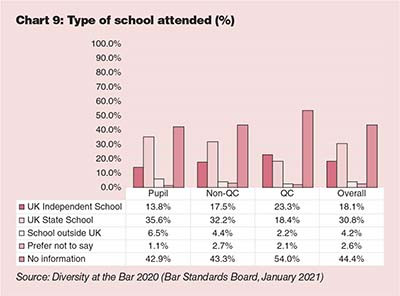*/

Most social mobility programs are targeted too late to be effective. There, I have said it. It’s a sweeping statement, and no doubt some of you have already started typing eloquent re-buffs, but please hear me out.
If we look at most of the great schemes aiming to open the legal profession to lower socio-economic groups, we see a common theme. They are aimed at those in the later stages of their postgraduate legal training or, often, university level. Is this the right stage to be targeting? I am going to argue that it is too late. Too late to make any significant difference.
The table below, taken from Diversity at the Bar 2020 (Bar Standards Board, January 2021), demonstrates what I mean. Of those who responded to the question on type of school attended, 18.1% said they came from independent schools and 30.8% from a state school. This compares with 7% of children having attended an independent school in England (6.5% in the UK) (Independent Schools Council, 2021).

What is also interesting is the low rate of response: 44.4%. Even if all those who chose not to respond to this question happened to be state-school educated, the proportion of barristers who went to independent schools would still be disproportionately higher than in the wider population.
If we look to alternative sources, the Sutton Trust published its first report on the educational backgrounds of the UK’s professional elite over a decade ago. This researched the schools and universities attended by barristers, judges, solicitors and other sectors. Since then, it has published over ten updates, the latest of which (in 2016) noted the ‘staying-power of the privately-educated at the top’ and that even when those with such backgrounds retire from the top of their field, ‘they are frequently replaced by those with a similar educational past’ (Leading People, Sutton Trust/Philip Kirby).
The Sutton Trust/Kirby study showed that 71% of barristers, and 74% of judges, attended independent schools – compared with 7% of the UK population; 78% of barristers, and 74% of judges, attended Oxbridge – compared with under 1% of the UK population. Whichever way we look at it, this is a highly significant deviation from the wider population. Furthermore, the Bar and judiciary (along with the military at 71%) top the list of sectors dominated by independent-school education; medicine follows at 61%; journalism is 51%; solicitors 51%; politics (Cabinet) 50%; Civil Service 48%; and business 34%.
Then think about this, how many of those who attend state school actually come from higher socio-economic groups? According to a 2019 article in the Guardian, 40% of children from families with income in excess of £300,000 p/a go to state schools (Britain’s private school problem: it’s time to talk, Francis Green and David Kynaston, The Guardian 13 January 2019). Currently, this is something as a profession we are less focused on, but is this masking yet further issues with our recruitment?
To assess progress in social mobility more accurately, the Sutton Trust’s Social Mobility Toolkit 2021 recommends looking at four areas in this order:
Interestingly, though, we concentrate our social mobility efforts, in the main, well after this stage. If I had not come from a working-class background, I might be using stable door and horse analogies here!
It is not radical to suggest we need to engage with potential entrants before they start studying for their legal qualifications; before they go to university; and before they sit their A-Levels.
An effective social mobility policy needs to start in secondary schools. Children can only opt to study for a career as a barrister if they know about it. They need to be shown what a great career option it can be, and that it is open to people like them. They need to know what A-Level options to choose. They need to know about funding sources that will enable them to shoulder the massive financial training burden. Only by engaging with children earlier will we ever start to succeed in our ambitions for social mobility. All other attempts will be akin to sticking a sandbag in the door as the dam breaks.

Most social mobility programs are targeted too late to be effective. There, I have said it. It’s a sweeping statement, and no doubt some of you have already started typing eloquent re-buffs, but please hear me out.
If we look at most of the great schemes aiming to open the legal profession to lower socio-economic groups, we see a common theme. They are aimed at those in the later stages of their postgraduate legal training or, often, university level. Is this the right stage to be targeting? I am going to argue that it is too late. Too late to make any significant difference.
The table below, taken from Diversity at the Bar 2020 (Bar Standards Board, January 2021), demonstrates what I mean. Of those who responded to the question on type of school attended, 18.1% said they came from independent schools and 30.8% from a state school. This compares with 7% of children having attended an independent school in England (6.5% in the UK) (Independent Schools Council, 2021).

What is also interesting is the low rate of response: 44.4%. Even if all those who chose not to respond to this question happened to be state-school educated, the proportion of barristers who went to independent schools would still be disproportionately higher than in the wider population.
If we look to alternative sources, the Sutton Trust published its first report on the educational backgrounds of the UK’s professional elite over a decade ago. This researched the schools and universities attended by barristers, judges, solicitors and other sectors. Since then, it has published over ten updates, the latest of which (in 2016) noted the ‘staying-power of the privately-educated at the top’ and that even when those with such backgrounds retire from the top of their field, ‘they are frequently replaced by those with a similar educational past’ (Leading People, Sutton Trust/Philip Kirby).
The Sutton Trust/Kirby study showed that 71% of barristers, and 74% of judges, attended independent schools – compared with 7% of the UK population; 78% of barristers, and 74% of judges, attended Oxbridge – compared with under 1% of the UK population. Whichever way we look at it, this is a highly significant deviation from the wider population. Furthermore, the Bar and judiciary (along with the military at 71%) top the list of sectors dominated by independent-school education; medicine follows at 61%; journalism is 51%; solicitors 51%; politics (Cabinet) 50%; Civil Service 48%; and business 34%.
Then think about this, how many of those who attend state school actually come from higher socio-economic groups? According to a 2019 article in the Guardian, 40% of children from families with income in excess of £300,000 p/a go to state schools (Britain’s private school problem: it’s time to talk, Francis Green and David Kynaston, The Guardian 13 January 2019). Currently, this is something as a profession we are less focused on, but is this masking yet further issues with our recruitment?
To assess progress in social mobility more accurately, the Sutton Trust’s Social Mobility Toolkit 2021 recommends looking at four areas in this order:
Interestingly, though, we concentrate our social mobility efforts, in the main, well after this stage. If I had not come from a working-class background, I might be using stable door and horse analogies here!
It is not radical to suggest we need to engage with potential entrants before they start studying for their legal qualifications; before they go to university; and before they sit their A-Levels.
An effective social mobility policy needs to start in secondary schools. Children can only opt to study for a career as a barrister if they know about it. They need to be shown what a great career option it can be, and that it is open to people like them. They need to know what A-Level options to choose. They need to know about funding sources that will enable them to shoulder the massive financial training burden. Only by engaging with children earlier will we ever start to succeed in our ambitions for social mobility. All other attempts will be akin to sticking a sandbag in the door as the dam breaks.


Chair of the Bar reflects on 2025
AlphaBiolabs has donated £500 to The Christie Charity through its Giving Back initiative, helping to support cancer care, treatment and research across Greater Manchester, Cheshire and further afield
Q&A with criminal barrister Nick Murphy, who moved to New Park Court Chambers on the North Eastern Circuit in search of a better work-life balance
Revolt Cycling in Holborn, London’s first sustainable fitness studio, invites barristers to join the revolution – turning pedal power into clean energy
Rachel Davenport, Co-founder and Director at AlphaBiolabs, reflects on how the company’s Giving Back ethos continues to make a difference to communities across the UK
By Marie Law, Director of Toxicology at AlphaBiolabs
Are you ready for the new way to do tax returns? David Southern KC explains the biggest change since HMRC launched self-assessment more than 30 years ago... and its impact on the Bar
Professor Dominic Regan and Seán Jones KC present their best buys for this holiday season
Marking one year since a Bar disciplinary tribunal dismissed all charges against her, Dr Charlotte Proudman discusses the experience, her formative years and next steps. Interview by Anthony Inglese CB
Little has changed since Burns v Burns . Cohabiting couples deserve better than to be left on the blasted heath with the existing witch’s brew for another four decades, argues Christopher Stirling
Pointillism, radical politics and social conscience. Review by Stephen Cragg KC